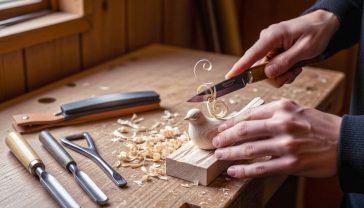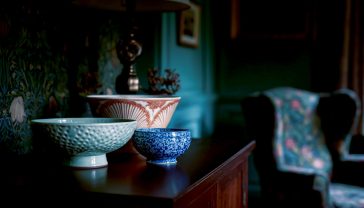The Ultimate Guide to Buying Perfume: Finding Your Perfect Scent in the UK
Your ultimate guide to navigating the world of fragrance. Discover scent families, learn how to test like a pro, and finally find your perfect perfume.

This post may contain affiliate links. If you make a purchase through these links, we may earn a commission at no additional cost to you.
Ever walked past someone in the street and been so captivated by their scent you almost turned around to ask what it was? Or perhaps a certain smell—cut grass, an old book, your mum’s favourite perfume—has transported you back to a specific moment in time with heart-stopping clarity. That’s the power of fragrance. It’s more than just a nice smell in a fancy bottle; it’s a memory, an identity, and a deeply personal statement.
But let’s be honest, finding the right one can feel like a mammoth task. Walking into the perfume hall of a big department store like Selfridges or John Lewis is an assault on the senses. You’re faced with a glittering wall of bottles, hundreds of competing smells, and sales assistants armed with little paper strips. It’s easy to feel overwhelmed, sniff a couple of things, and walk out with either nothing at all or a headache and a hastily chosen bottle you’re not quite sure you even like.
Don’t worry. This guide is here to change that. We’re going to demystify the world of perfume, from the jargon on the bottle to the art of testing it properly. Think of this as your friendly, no-nonsense map to navigating the fragrance maze. By the end, you’ll understand what you’re smelling and have the confidence to find a scent—or several—that feels authentically you. It’s a journey, not a test, and it’s one of the most rewarding acts of self-expression you can embark on. So, let’s get started.
The Absolute Basics: Understanding the Language of Scent
Before you can find a perfume you love, it helps to speak the language. Perfumers use specific terms to describe how a scent is built and how it performs. Getting your head around these core concepts is the first and most important step.
The Scent Pyramid: A Perfume’s Three-Act Story
Most fragrances aren’t just one single smell; they’re a complex blend of different ingredients, known as notes. These notes unfold over time in a structure called the fragrance pyramid. Think of it like a piece of music with a beginning, a middle, and an end. What you smell when you first spray a perfume is not what you’ll smell a few hours later.
Top Notes: The First Impression
The top notes are what you smell immediately after spraying. They’re made of the smallest, lightest molecules, so they burst out in a vibrant opening but also evaporate the quickest—usually within 5 to 15 minutes. Their job is to grab your attention and make that initial impression.
- Common Examples: Citrus scents like lemon, bergamot, and grapefruit; light herbs like mint and basil; and airy fruits like pineapple or berries. They provide a feeling of freshness and sparkle.
Middle (Heart) Notes: The Main Event
Once the top notes have faded, the heart of the fragrance emerges. These middle notes form the main body of the perfume and determine which scent family it belongs to. They are more rounded and complex, sticking around for a good few hours. This is the true character of the scent.
- Common Examples: Floral notes like rose, jasmine, and lavender; spicy notes like cinnamon or nutmeg; and green notes like freshly cut grass.
Base Notes: The Lingering Memory
Finally, we have the base notes. These are the rich, heavy notes that anchor the fragrance and give it its depth and longevity. They are made of the largest molecules, so they evaporate the slowest. You might not even notice them until the perfume has been on your skin for at least half an hour, but they’re the ones that will linger on your jumper the next day.
- Common Examples: Woody notes like sandalwood and cedarwood; resins like frankincense; and sweet, comforting notes like vanilla, amber, and musk.
Why this matters: Never, ever buy a perfume based on the first sniff alone! You’re only smelling the top notes. You need to let it live on your skin to experience the full story—the heart and the base—to know if you truly love it.
Strength in Numbers: What Do EDT, EDP, and Parfum Mean?
You’ve seen the little letters on the bottles: EDT, EDP. They’re not just random acronyms; they tell you the concentration of pure perfume oil in the bottle. The higher the concentration, the more potent the scent and, generally, the longer it will last.
Think of it like making a cup of tea. A higher concentration is like leaving the teabag in for longer—you get a stronger, richer result.
Eau de Cologne (EDC)
This is the lightest and most refreshing concentration. With only 2-4% perfume oil, it’s a light splash of scent that will typically last for a couple of hours. It’s perfect for a hot summer’s day or when you just want a subtle hint of fragrance.
Eau de Toilette (EDT)
This is probably the most common concentration you’ll find on the high street. An EDT contains 5-15% perfume oil. It’s still relatively light and fresh but has more presence than a cologne, usually lasting around 3 to 5 hours. It’s a great choice for everyday wear or for the office.
Eau de Parfum (EDP)
An EDP is a step up in intensity, with 15-20% perfume oil. The heart notes often shine through more prominently, making the scent richer and more complex. It will comfortably last for 5 to 8 hours, making it ideal for a full day or an evening out. You’ll find that many popular fragrances are released as both an EDT and an EDP, and they can sometimes smell surprisingly different, not just stronger.
Parfum (or Extrait de Parfum)
This is the big one. With 20-30% perfume oil, Parfum is the most concentrated, luxurious, and expensive form of fragrance. A tiny dab can last for an entire day (and sometimes into the next). The scent unfolds slowly and stays close to the skin, creating a more intimate and subtle aura rather than a loud projection.
Why this matters: Knowing the concentration helps you manage expectations. Don’t be disappointed when your light, citrusy Eau de Cologne fades by lunchtime—that’s what it’s designed to do! If you want a scent to last from your morning commute to after-work drinks, you’ll want to look at an Eau de Parfum or Parfum.
Finding Your Tribe: The Fragrance Families
Just like wines or music genres, perfumes can be grouped into “families” based on their dominant characteristics. Knowing which family you’re naturally drawn to is a massive shortcut to finding scents you’ll love. While there are lots of sub-categories, most fragrances fall into one of four main families.
The Fragrance Wheel: A Map to Your Scent Preferences
The industry standard for classifying scents is the Fragrance Wheel, developed by scent expert Michael Edwards. It organises families and their sub-groups in a circle, showing how they relate to each other. For example, a scent might be a Floral Oriental, meaning it sits between the two families.
The Four Main Families
- Floral: This is the largest and most popular family. It covers everything from the scent of a single flower (like a rose) to a complex bouquet of many. They can be light and powdery, sweet and fruity, or even slightly spicy.
- Think: Freshly cut flowers, wedding bouquets, a walk through a garden in spring.
- Iconic Examples: Chanel No. 5 (a powdery, abstract floral), Dior J’adore (a bright floral bouquet), Gucci Bloom (a modern white floral).
- Amber (formerly known as Oriental): Rich, warm, spicy, and sensual, this family takes its inspiration from the historic perfumes of the Middle and Far East. These are opulent and heady scents, often built around notes like vanilla, exotic spices, and resins.
- Think: A bustling spice market, incense burning in a temple, a rich Christmas pudding.
- Iconic Examples: Guerlain Shalimar (the original amber vanilla), Yves Saint Laurent Opium (spicy and dramatic), Tom Ford Tobacco Vanille (a modern, sweet, and smoky take).
- Woody: As the name suggests, this family is dominated by the smells of woods and mosses. Scents can range from creamy and smooth (like sandalwood) to sharp and smoky (like cedarwood or vetiver). They often feel grounding, elegant, and earthy.
- Think: A walk in a damp forest after it’s rained, the smell of a freshly sharpened pencil, a crackling log fire.
- Iconic Examples: Le Labo Santal 33 (a cult creamy sandalwood), Terre d’Hermès (earthy and citrusy vetiver), Penhaligon’s The Tragedy of Lord George (a warm, boozy wood).
- Fresh: This broad family covers all things bright, zesty, and clean. It’s often broken down into sub-families like Citrus (lemon, bergamot), Water/Aquatic (sea salt, rain), Green (cut grass, mint), and Aromatic (lavender, rosemary). These are invigorating and uplifting scents.
- Think: A gin and tonic with a slice of lime, a fresh sea breeze on the coast, clean laundry drying in the sun.
- Iconic Examples: Acqua di Parma Colonia (a classic Italian citrus), Davidoff Cool Water (the original aquatic scent), Jo Malone London Lime Basil & Mandarin (a modern aromatic citrus).
Why this matters: Once you identify a family you like, you can ask for recommendations within that group. If you know you love the smell of vanilla and spice, you can confidently explore the Amber family. If you always go for clean, zesty scents, the Fresh family is your playground.
Beyond the Bottle: Designer, Niche, and the Scent In-Between
The brand behind the perfume can also tell you a lot about the style of scent you can expect. The market is generally split into two main camps: designer and niche.
Designer Fragrances: The Familiar Faces
These are the perfumes you’ll see advertised in magazines and on TV, from big fashion houses like Chanel, Dior, and Gucci, or beauty giants like Lancôme.
- What they are: Designer fragrances are made for a mass audience. They are extensively market-tested to be as widely appealing as possible. This isn’t a bad thing—it means they are often very easy to wear and love.
- Pros: Widely available in department stores and chemists like Boots; generally more affordable; often sets trends.
- Cons: You might smell it on a lot of other people. They can sometimes feel less unique or daring.
Niche Fragrances: The Artisanal Approach
Niche perfume houses focus exclusively on creating fragrances, not on selling handbags or clothes. They are the perfume world’s equivalent of an independent art-house cinema or a craft brewery.
- What they are: Niche brands like Le Labo, Byredo, Creed, or British houses like Penhaligon’s and Miller Harris produce scents in smaller batches, with a greater focus on artistic expression and unique, high-quality ingredients. The perfumer (the “nose”) often has much more creative freedom.
- Pros: More unique and distinctive scents; often tell a specific story; can feel more personal and luxurious.
- Cons: Harder to find (you’ll need to go to specialist boutiques or high-end department stores); significantly more expensive.
A Quick Word on Naturals vs. Synthetics
There’s a common misconception that “natural” ingredients are always better. In reality, modern perfumery is a beautiful blend of both natural and synthetic (lab-created) molecules.
- Naturals (like rose absolute or sandalwood oil) are complex and beautiful but can vary from batch to batch, be incredibly expensive, and sometimes involve unethical practices (like animal-derived musk).
- Synthetics are a perfumer’s best friend. They offer consistency, ethical alternatives, and allow for the creation of smells that can’t be bottled from nature, like the scent of ozone before a storm. Almost every perfume you’ve ever smelled contains synthetics. Synthetic does not mean cheap or bad; it means creative and consistent.
The Practical Art of Perfume Hunting: A Step-by-Step Guide
Right, you’ve got the theory down. Now for the fun part: actually going out and finding a perfume. Here’s how to approach it methodically to avoid getting overwhelmed.
Step 1: Do Your Homework (Before You Leave the House)
Don’t go in blind. Spend a little time thinking about what you like.
- Think about smells you already love. Do you love the smell of your morning coffee? The vanilla in a cake? A specific flower in your garden? Your partner’s leather jacket? These are all clues.
- Do some online research. Websites like Fragrantica or Basenotes are incredible resources. You can look up a perfume you already know and like, and it will tell you its notes and what scent family it belongs to. It will also suggest other perfumes with a similar feel. This helps you build a “wish list” of scents to try.
- Decide on a budget. Perfume prices vary wildly. Knowing how much you’re willing to spend will help you narrow down your search.
Step 2: The Field Trip – How to Test Perfumes Like a Pro
You’ve got your list. It’s time to head to the shops. To get the most out of your visit, follow these simple rules.
The Great Blotter vs. Skin Debate
Those little paper strips (blotters) are useful for a first impression. They let you quickly weed out any scents you immediately dislike without covering yourself in them.
However, you must test a perfume on your skin before you buy it. Everyone’s skin chemistry is different (due to factors like diet, hormones, and skin type). A perfume will smell slightly different on you than it does on paper or on your best mate. Skin is the final, magic ingredient.
The Golden Rule: Let It Dry Down
When you test on your skin, spray it on your wrist or the back of your hand. Then—and this is the important bit—leave it alone. Don’t rub your wrists together! This old habit actually crushes the delicate top notes and heats up the skin, changing how the scent develops.
Walk away. Go and have a coffee. Do the rest of your shopping. You need to give the perfume at least 20-30 minutes to settle and let the heart notes come through. Give it a few hours, and you’ll get to experience the base notes. This is the only way to know if you love the entire fragrance journey, not just the opening act.
Don’t Overload Your Nose
Your nose gets tired quickly. After sniffing three or four different perfumes, you’ll start to struggle to tell them apart. This is called olfactory fatigue.
Stick to testing a maximum of four scents per visit—one on each wrist and one on the inside of each elbow. And forget sniffing coffee beans in between; it’s a myth that it “resets” your nose. The best thing to do is to sniff an unscented part of your own skin (like your sleeve) or simply step outside for some fresh air.
Step 3: Living with the Scent – The Power of the Sample
Even after testing on your skin in-store, the best way to be 100% sure is to live with a scent for a full day. The environment of a perfume hall is saturated with smells, which can cloud your judgment.
Don’t be shy about asking for a sample. Most department store counters are happy to give you a small vial to take home. This allows you to test the fragrance in your own environment, see how it makes you feel throughout the day, and check its longevity. Does it still smell good after your commute? Do you get pleasant whiffs of it while you’re working? Do you still love it 8 hours later? This is the ultimate test.
You’ve Found “The One” (or a Few): Making It Work for You
Congratulations! You’ve found a scent you adore. Here’s how to make the most of it.
How and Where to Apply Perfume
The goal is to apply fragrance to the parts of your body that generate heat. This helps to project and diffuse the scent throughout the day. These are known as pulse points.
- The Best Spots: Wrists (don’t rub!), the base of the neck, behind the ears, inside the elbows, and behind the knees.
- Less is More: Start with one or two sprays. You can always add more, but you can’t take it away. You want your scent to be discovered, not to announce your arrival from the next room.
- Hair and Clothes: A light spritz on your hair or a scarf can be a great way to hold a scent, as they are porous. Be careful with clothes, as some perfume oils can stain delicate fabrics like silk.
Top Tips for Making Your Fragrance Last Longer
If you feel like your scent disappears by mid-morning, try these tricks:
- Moisturise First: Perfume lasts longer on hydrated skin than on dry skin. Apply an unscented lotion or body oil before you spray your fragrance.
- Layer Your Scents: Many popular fragrances come with matching body lotions or shower gels. Using these products together builds up layers of the scent, which dramatically increases its staying power.
- Apply Post-Shower: The steam from a warm shower opens up your pores, which can help your skin absorb the fragrance more effectively.
How to Store Your Perfume Properly
Perfume is a delicate thing. Light, heat, and air are its worst enemies, as they can break down the fragile molecules and spoil the scent.
Your bathroom is the worst place to store perfume! The constant changes in heat and humidity will ruin it over time.
To keep your collection safe and smelling its best, store your bottles in a cool, dark, and dry place—like a drawer in your bedroom or inside a cupboard. And always keep the cap on tight.
Common Mistakes to Avoid on Your Fragrance Journey
We all make them, but here are a few common pitfalls to watch out for:
- Blind Buying: Buying a full bottle of a perfume online just because you’ve read good reviews or liked the description. Always, always try a sample first.
- Buying for a Compliment: Don’t choose a scent just because someone else likes it. You’re the one who has to wear it all day, so you have to be the one who loves it.
- Rushing the Decision: Buying a perfume in a hurry in an airport duty-free is rarely a good idea. Give yourself time.
- Judging a Perfume by its Brand or Price: An expensive niche perfume isn’t automatically better than an affordable designer one. Trust your own nose, not the price tag.
Building Your Fragrance Wardrobe: Beyond the Signature Scent
In the past, many people had one “signature scent” that they wore every single day. While that’s a lovely idea, more and more people are now building a “fragrance wardrobe”—a small collection of different scents for different moods, seasons, and occasions.
You wouldn’t wear the same coat in summer that you wear in winter, so why wear the same fragrance?
- For Spring/Summer: You might gravitate towards lighter, fresher scents—citrus, light florals, or aquatic notes that feel uplifting in the warmer weather.
- For Autumn/Winter: As the weather turns colder, you might crave richer, warmer, and cosier scents—spicy ambers, comforting vanillas, and deep woody notes that feel like a warm hug.
- For Work: Something clean, subtle, and inoffensive is usually best. A light EDT is a great choice.
- For a Date Night or Special Occasion: This is the time to bring out something with a bit more personality and presence—a rich Eau de Parfum that makes you feel confident and special.
Building a wardrobe doesn’t have to be expensive or happen overnight. It’s something you can slowly and thoughtfully curate over time, adding a new bottle when you find something you truly can’t live without.
Conclusion: Your Scent, Your Story
Finding the perfect perfume is a journey of discovery. It’s about more than just smelling good; it’s about finding something that resonates with you, boosts your confidence, and becomes a part of your personal story. There are no right or wrong answers, only what you love.
So, take your time. Trust your instincts. Don’t be afraid to try something new, and most importantly, have fun with it. The world of fragrance is a vast and beautiful place, and your perfect scent—or scents—is out there waiting for you. Happy hunting!
Further Reading
For those who wish to dive even deeper into the world of perfumery, these resources are highly respected and endlessly fascinating:
- Fragrantica: An online encyclopedia of perfumes, a perfume magazine, and a community of perfume lovers. You can search for almost any perfume and see its notes, read reviews, and find similar scents.
- Basenotes: Another long-standing and respected online fragrance community with a massive database of scents and active discussion forums.
- The Perfume Society: A UK-based organisation offering beautifully written content, discovery boxes, and events for fragrance enthusiasts.
- Liberty London’s Fragrance Hall: A great place to browse online for both iconic and hard-to-find niche fragrances, offering excellent brand curation.






